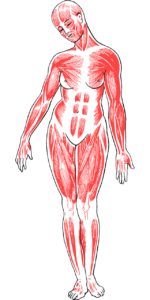How do we distinguish our body from the rest of the world?
Your Sixth Sense: Proprioception
Since primary school, I have been taught that we had 5 senses – vision, taste, smell, hearing and touch. These are appreciable, easy to understand senses. They follow a rule and have an organ to facilitate each of them – eyes for vision, tongue for taste, nose for smell, ears for hearing and skin for touch. These senses simply make sense. But what if I told you all of us had a sixth sense? No, this is not your telepathic sixth sense reading your best friend’s mind across the room. It is not your psychic sense determining your ability to predict the weather or if the next train leaving Paddington station will be delayed. Your sixth sense if not something to be flippantly referred to for inconceivable special powers. It is real, it is indispensable.
The notion that humans have 5 senses is wildly out of date making the current Cambridge/Oxford Dictionary definition of ‘Sixth Sense’ pretty ludicrous. You have another sense, your sixth sense, without which no human body will be able to interact with the world around it. It is the sense of ‘self-movement’, the sense of force and effort and the sense of heaviness. This sense is intangible, but it’s essential. It is called “Proprioception.”
Proprioception gives us information on the location, movement, and actions of our body parts. It is the reason we can distinguish out body from the rest of the world. It is what allows us to track our body movements and postures. Without it, we’d have no bodily sense of “self”. Sounds a bit like smoke and mirrors? Probably. It’s not easy to grasp for the full importance of proprioception and consequently this sense is often underrated. So let me start with medical disorders where proprioception goes wrong and then what emerges is a rather striking yet poignant clinical picture.
Dr Oliver Sacks: The Disembodied Lady
I read about a case in Dr Oliver Sack’s Book “The Man Who Mistook His wife for a Hat.” In his chapter titled the “The Disembodied Lady” he discusses a curious case of young, energetic 27 years old Christina admitted for a routine gall bladder operation. She was admitted a few days prior to the operation for the usual pre-operative preparations and prophylactic antibiotics. However, what ensued prior to her operation was unimaginable. She had lost control over her body, she was unsteady of her feet, her hands were flailing and overshooting, and she kept dropping things. This was initially passed off as pre-operative anxiety hysteria, but this was far from it. After a series of electric muscle test and nerve conduction studies the most unusual picture began to emerge. She also had a lumbar puncture, where a needle is inserted into the spinal area to get a fluid sample. The procedure is a bit like an epidural we give to pregnant ladies but instead of giving anaesthetic in we take cerebrospinal fluid sample out and analyse it for various bits like inflammation and infections. It showed that this lady had acute polyneuritis – which is inflammation of the nerves. But this pattern of inflammation was most unusual where it predominantly affected her ‘proprioception’: and she had lost ALL sense of it from head to toe.
In Dr Sacks’ book, he writes says Christina says “Proprioception is like the eyes of body, the way the body sees itself. And if it’s gone, it’s like the body is blind.” The normal unconscious feedback loops of proprioception where you constantly know where you are in a particular space, even if you close your eyes or try to reach out for your phone on the dark were all gone in Christina. The only way to even begin to start compensating for this is to use your eyes to see the body and readjust your movement and posture so that your body does what you want it to do were gone. But this hypervigilance to movements can allow you to function, walk, take the train and public transport but it cannot fully compensate what is lost in proprioception. For example, If Christina’s attention is elsewhere when eating, she can dig too deeply when holding a spoon her fingertips can go bloodless with pressure. For more on Christina’s story and 23 other fascinating patient stories of neurology, I highly recommend Oliver Sacks “The Man Who Mistook His Wife for a Hat.
Ian Waterman: “The Man Who Lost his Body” (BBC Horizon)
There are a few other patients like Dr Sacks’ Christina who have dysfunction of proprioception. One of the most notable cases in literature of Mr Ian Waterman who was only 19 when he was struck with a virus that led to permanent damage to his neurons sensing touch and proprioception. This occurred in 1971 when the knowledge surrounding proprioception was so limited, his condition didn’t even have a name. His story is poignantly yet inspiringly captures in the BBC Horizon Documentary “The Man who Lost his Body”. Ian woke up one day to find that he has lost all control of his body from the neck down. That was the day his life just changed overnight. His muscles and joints had the ability to work, but he had lost his brain-body connection. He couldn’t command over his limbs, he couldn’t control them, he couldn’t even feel them. The nerves that once told his body what to do was destroyed by the virus. Doctors had pronounced him incurable and sent him to a life in a wheelchair.
Ian however was not going to give up. His determination, willpower and perseverance is a true inspiration. Ian knew he couldn’t restore his damaged nerves, so he had to bypass them. And Bypass he did, slowly but surely, by visualising and plotting his movements before executing them. He used his eyes instead of proprioception to gain feedback on what his arms and legs were doing and fine tune his movements accordingly. The documentary mentions that Ian took four months to learn how to put on a sock, and an incredible two years on how to stand safely – things that were subconscious and automatic to him once now had to be a carefully planned exercise requiring an astonishing degree of mental energy. It wasn’t just with movement he had to expend a lot of brain and visual power, constantly. It was with his balance too. He had to anticipate how his centre of gravity would shift when doing simple tasks, like shopping. Picking up vegetables like potatoes of varying weight, particularly the heave ones. He had to keep his feet apart with a broad base, freeze his legs and upper torse a bit so he knows he is in a safe rigid position and wouldn’t topple over when picking heavy objects. Eggs were even more of a challenge. They are fragile and one is required to have fine control of pressure within the fingers. Too much, he crushes them; too little, he drops them.
What Ian achieved was remarkable. But analysing his brain activity in a scanner a scanner was proof as to how much more hard work to appear to function “normally”. He worked as a statistician and disability access audit consultant. He also set up a company conserving traditional varieties of turkeys. While it is undoubtable that Ian’s triumph is unprecedented and extraordinary, he is not normal. As soon as the lights go out and he loses his vision, he collapses
So, what has exactly is the cause behind this extraordinary clinical picture?
Our sixth senses, like proprioception, are unlike the other senses – they are unconscious, automatic and have largely been undiscovered. Victorians vaguely recognised a “muscle sense” referring to position of limbs and trunk and the term “proprioception” only began to be defined in the 1890s. It didn’t infiltrate into the clinical picture until much later and Ian’s condition only got a name as recently in 1979, a long 8 years after he was inflicted with this predicament. Indeed, the complex mechanisms which underpin our sixth sense, proprioception, is only beginning to be understood in the 21st century.
Our sixth senses, like proprioception, are unlike the other senses – they are unconscious, automatic and have largely been undiscovered. Victorians vaguely recognised a “muscle sense” referring to position of limbs and trunk and the term “proprioception” only began to be defined in the 1890s. It didn’t infiltrate into the clinical picture until much later and Ian’s condition only got a name as recently in 1979, a long 8 years after he was inflicted with this predicament. Indeed, the complex mechanisms which underpin our sixth sense, proprioception, is only beginning to be understood in the 21st century.
The story of two theories: In the brain or in the body
The idea of “muscle sense” which we now know as “proprioception” first began to be debated in the 19thcentury. Some of the initial ideas from german physiologists was that sense of where out body was in space was generated centrally within the brain – that is as we willed an action, like picking up a teacup, our brain would know where our arms and were going based on the action we had just commanded them to do. Does that make sense?


But what happens when you are relaxing, lying on a beach, sunbathing? You haven’t commanded your body to do any action, but you still have an intact sense of body image and know where your arms and legs are. This observation led to Sir Charles Sherrington, a Nobel Prize winning physiologist, to reject the idea that muscle sense had a central brain origin. He hypothesised the that our “muscle sense” originates peripherally – that is the origin of muscle sense signals starts from the body itself rather than the brain.
The story of three theories: the muscles, the joints or the tendons
Sherrington’s theory was the most popular prevailing theory at the start of the 20th century which was that “muscle sense” or “proprioception” as we now know it, originated peripherally in the body. But from where exactly? One of the obvious places to look for receptors that signal limb position would be in the joint about which the limb moves. Surely the elbow joint should know which way your arm was lying? Or you hip joint will tell you how far your hip was flexing? It is a common-sense theory with some not-so-common-sense flaws.
If your joints did indeed signal to your brain where your limb was positioned, what would happen to little granny who recently had a new hip fitted in? She theoretically shouldn’t be able to tell where her leg was. Hip joint replacements involve the removal of the joint capsule and native ligaments leaving you behind with metal, ceramic and plastic for your hip instead. Surely these man-made materials couldn’t be signalling to the brain which was the hip is going. So why is the sense of body position in patients with hip replacements preserved? In fact, proprioception is it pretty much entirely unaffected after joint replacements that patient can get up and begin playing tennis and golf again with their brand-new osteoarthritis-free hips.
So surely, sense of “self”, “body position and movement” must originate somewhere other than the joints. The current theory is that the muscle spindle fibres are the major sensors of body movement followed by tendons to a lesser extent. They have worked this out by studying the pattern of injuries in the spinal cord and how this affects sense of body position and doing some fancy experiments where an illusion of movement is created by artificially vibrating muscles. The BBC Horizon Documentary mentions that as Mr Ian Waterman’s immune system was attacking the virus he had contracted, there were some proteins in the virus which had a very similar shape of the dorsal root ganglion cells of his nervous system. This caused his immune system to not just attack the virus, but due to molecular mimicry also attack the cell bodies of nerves which were responsible for carrying information about touch and proprioception from his muscle spindles to the brain.
Proprioception mystery solved? Not, really.
Imagine how you feel an intense workout for a gym, or after sprinting for a bus. Have you ever felt awkward and clumsy? Have you felt unsure where to place your feet? Have you misjudged the force with which to pick up a glass or open the door? Heavy exercise can impair proprioception. How does it do that? I’m not entirely sure, but what I can get is that functioning nerves are just not enough for full proprioception. Muscle fatigue seems to modulate it, albeit temporarily and I can’t claim any of my reading has given me a convincing answer as to how that happens. Another example is Sarcopenia where you lose muscle bulk as you age. Elderly patients also seem to have impaired proprioception as they age – why is that?. Is it reduced muscle bulk? Or is it the reduced sensing ability of the muscle to detect limb position? A bit of both? Or Neither?
We are only beginning to unravel the mechanisms of proprioception and we still have a long way to go.
The PIEZO2 Breakthrough
In fact, a lot of our understanding about the complex mechanisms behind proprioception needs a lot more work. There are patients like Ian and Christina who lost proprioception in their lifetime, but there are others who are born without it. The first two cases were documented as recently as 2016, that’s LESS than 10 years ago. Dr Bonnemann’s team at the National Institute of Neurological Disorders and Stroke identified a catastrophic mutation in the PIEZO2 gene in two young patients who both lacked awareness of their body position. These patients did not know what they never had unlike are other two patients and since birth had been compensating using their vision. They would struggle to find their nose on their face as they could not see it and even begin to feel disorientated if someone leaned in too close to kiss as it blocked peripheral vision. PIEZO2 codes for a receptor which transduces mechanical information about limb position (and touch) into electrical signals that can be read by the brain – In short, PIEZO2 is critical for proprioception.
Even the world’s experts have very limited information on the mechanisms behind our sixth sense. They are mysterious, but they are unmistakeably present. The difference is that other in our other senses there is an external stimulus – like light or sound – but with proprioception the body acts a stimulus to itself – the “proprioceptors.” If proprioception is destroyed, the body essentially becomes blind and dead to itself and ceases to own itself as itself, to feel itself as itself. And we are only beginning to appreciate, understand and become aware of the hidden mysteries which have been part of our being since the beginning of time. Could PIEZO2 be our gene for our sixth sense? Would I have been able to dabble at my dancing skills at all without it?

Aristotle firmly believed we have five senses. We now know that he got it wrong. But do we just have a sixth sense or do we 7th, 8th, 9th more hidden senses? We almost definitely have more. Our sense of balance, have you ever appreciated it? How do we do that? We have sophisticated mechanism for it, the vestibular system, which lies in our inner ear. But I shall leave the wonder of our sevenths sense for another time and day….